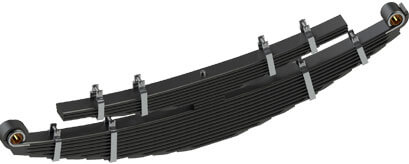
In the realm of automotive engineering, the conventional leaf spring remains a fundamental component, providing vital support and stability to vehicles across various terrains. In India, a country renowned for its manufacturing prowess, the journey of conventional leaf springs from raw materials to road-worthy products is a testament to precision engineering, innovation, and skilled craftsmanship.
Raw Materials:
The journey begins with the selection of raw materials, a crucial step that sets the foundation for the leaf spring’s performance and durability. High-quality steel, typically sourced from reputable suppliers, forms the primary material for leaf spring production. The steel undergoes rigorous testing to ensure it meets the required specifications for strength, flexibility, and corrosion resistance. In recent years, advancements in metallurgy have led to the development of specialized alloys tailored to enhance the performance of leaf springs, reflecting India’s commitment to innovation in manufacturing.
Design and Engineering:
Once the raw materials are acquired, the next phase involves design and engineering. Skilled engineers and designers employ advanced software and computational tools to conceptualize and refine the geometric and mechanical properties of the leaf spring. Factors such as vehicle weight, load capacity, ride quality, and suspension geometry are meticulously considered during the design process. In India, manufacturers leverage both traditional knowledge and modern technologies to optimize the design of leaf springs, ensuring they meet the diverse needs of customers across different sectors, including commercial vehicles, agriculture, and off-road vehicles.
Manufacturing Process:
With the design finalized, production moves to the manufacturing floor, where precision machinery and skilled labor bring the leaf spring to life. The manufacturing process typically involves several key steps:
1. Cutting and Shaping: The steel sheets are cut into precise dimensions according to the design specifications. Advanced cutting techniques such as laser cutting or water jet cutting ensure accuracy and consistency in the shape of the leaf spring components.
2. Heating and Forming: The cut steel blanks are then heated to a specific temperature to improve their malleability. They are subsequently formed into the desired shape using hydraulic presses or rolling mills. This step is critical for imparting the necessary curvature and taper to the leaf spring, ensuring optimal load distribution and ride comfort.
3. Quenching and Tempering: After forming, the leaf springs undergo heat treatment processes known as quenching and tempering. Quenching involves rapidly cooling the steel to harden it, while tempering involves reheating the steel to a lower temperature to improve its toughness and ductility. These heat treatment processes enhance the strength and resilience of the leaf spring, enabling it to withstand the rigors of constant loading and road vibrations.
4. Shot Peening and Surface Treatment: To further enhance the fatigue resistance and longevity of the leaf spring, shot peening is often employed to induce compressive stresses on the surface of the steel. This helps to prevent the propagation of cracks and surface defects. Additionally, surface treatments such as painting, powder coating, or galvanizing are applied to protect the leaf spring from corrosion and environmental degradation.
Quality Assurance:
Throughout the manufacturing process, stringent quality control measures are implemented to ensure that each leaf spring meets the highest standards of performance and safety. Quality inspectors conduct comprehensive inspections at various stages of production, checking for dimensional accuracy, material integrity, surface finish, and mechanical properties. Non-destructive testing techniques such as ultrasonic testing and magnetic particle inspection are also employed to detect any defects or irregularities that may compromise the integrity of the leaf spring.
Testing and Validation:
Before being released for shipment, the finished leaf springs undergo rigorous testing and validation procedures to verify their performance under real-world conditions. This may involve static load testing, fatigue testing, and dynamic testing on specialized test rigs or vehicle prototypes. By subjecting the leaf springs to simulated operating conditions, manufacturers can identify any potential issues and make necessary adjustments to ensure reliability and durability in service.
The journey of conventional leaf springs from raw material to road-worthy products exemplifies the synergy of craftsmanship, technology, and innovation in the Indian manufacturing industry. Through meticulous design, precision engineering, and robust quality control measures, Indian manufacturers continue to supply high-quality leaf springs that serve as the backbone of vehicle suspension systems worldwide. As the automotive landscape evolves, driven by advancements in mobility and sustainability, India remains at the forefront of leaf spring manufacturing, adapting to new challenges and pushing the boundaries of excellence in engineering and production.




